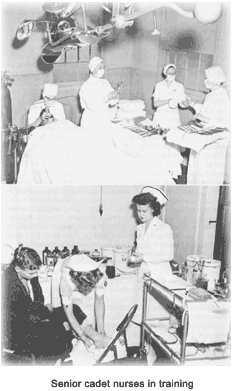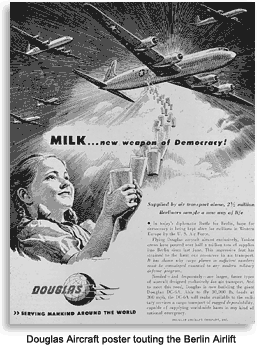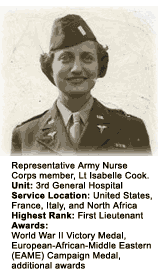World War II was the largest and most violent armed conflict in the history of mankind. Army nurses played a vital role in the support of countless combat troops during that war.
Only 82 army nurses were stationed in Hawaii the day of the Japanese surprise attack on Pearl Harbor. As the United States entered World War II, the Army Nurse Corps listed fewer than 1,000 nurses in active duty. The tremendous manpower needs suddenly faced by the U.S. created new social and economic opportunities for American women.
The need for nurses suddenly threw the status of the American nursing profession into sharp relief. Appalling shortages proved to be fatal in some circumstances. Army nurses found themselves in traumatic conditions, working side by side with civilian nurses who were called to duty because of the lack of manpower. Severe shortages of medical supplies aggravated the situation. Numerous nurses (and doctors) used cleaning rags as face masks and operated without the protection of gloves.
 The U.S. armed forces' demand for nurses created a shortage of civilian nurses. In June 1943 Congress passed the Bolton Act, which created the Cadet Nurse Corps program. Subsidized by the U.S. government, the program stipulated that nursing students would engage in essential military or civilian nursing for the duration of the war. Cadet nurses spent the last months of their training in civilian or military hospitals, to help alleviate the critical nursing shortage.
Women from all walks of life entered the nursing field. In July 1943, Lt. General Brehon B. Somerell, commanding general of the Army Service Forces, authorized a formal four-week training course for newly commissioned army nurses. Within months, there were reportedly 12,000 nurses on duty in the Army Nurse Corps. The government at that time provided free education to all nursing students.
Nurse anesthetists also were in short supply, so the army developed a special training program for 2,000 nurses. The six-week course taught students how to administer anesthesia, blood and blood derivatives, and oxygen therapy. They in turn taught army medics the proper methods of treating wounded soldiers with those therapies.
The number of psychiatric patients rose during the war. One in 12 patients in army hospitals was under psychiatric care; altogether, the Army discharged approximately 400,000 of them. The surgeon general developed a 12-week course to train nurses in the care and medication of such patients.
By December 1943, the War Department determined that there were enough nurses in the Army Nurse Corps. The American Red Cross, which was responsible for the recruitment of nurses, was now instructed to discontinue the recruitment. Much to the dismay of those involved, word got out that there was intensive planning in the spring of 1944 for the Allied invasion of France — with a high number of casualties anticipated.
The U.S. armed forces' demand for nurses created a shortage of civilian nurses. In June 1943 Congress passed the Bolton Act, which created the Cadet Nurse Corps program. Subsidized by the U.S. government, the program stipulated that nursing students would engage in essential military or civilian nursing for the duration of the war. Cadet nurses spent the last months of their training in civilian or military hospitals, to help alleviate the critical nursing shortage.
Women from all walks of life entered the nursing field. In July 1943, Lt. General Brehon B. Somerell, commanding general of the Army Service Forces, authorized a formal four-week training course for newly commissioned army nurses. Within months, there were reportedly 12,000 nurses on duty in the Army Nurse Corps. The government at that time provided free education to all nursing students.
Nurse anesthetists also were in short supply, so the army developed a special training program for 2,000 nurses. The six-week course taught students how to administer anesthesia, blood and blood derivatives, and oxygen therapy. They in turn taught army medics the proper methods of treating wounded soldiers with those therapies.
The number of psychiatric patients rose during the war. One in 12 patients in army hospitals was under psychiatric care; altogether, the Army discharged approximately 400,000 of them. The surgeon general developed a 12-week course to train nurses in the care and medication of such patients.
By December 1943, the War Department determined that there were enough nurses in the Army Nurse Corps. The American Red Cross, which was responsible for the recruitment of nurses, was now instructed to discontinue the recruitment. Much to the dismay of those involved, word got out that there was intensive planning in the spring of 1944 for the Allied invasion of France — with a high number of casualties anticipated.
 The War Department advised the War Manpower Commission to revise its earlier decision, and a new quota was set at 50,000 recruits in late April. The army reflected the immediate need in June 1944 by granting its nurses officer's commissions, full retirement privileges, dependents allowances and equal pay.
As World War II wore on, the Army Nurse Corps was dispatched to various locations throughout the world. They served in North Africa, England, Burma and the Southwest Pacific. Each day they not only met the challenges of combat casualties, but constantly faced attacks and evacuation procedures. Some of the hospitals were situated between ammunition dumps and airfields, both of which were prime targets for German bombers.
With supplies strained to the limit, medical units usually encountered frequent delays. The nurses often slept out in the open without the protection of tents, waiting and watching for their much-needed equipment. Nevertheless, the nurses were patient, flexible, innovative, quick thinking, adaptable and versatile. Subject to communicable disease, lack of proper rest, nutrition and warmth, the Army Nurse Corp served relentlessly increasing numbers of the wounded during the war.
The War Department advised the War Manpower Commission to revise its earlier decision, and a new quota was set at 50,000 recruits in late April. The army reflected the immediate need in June 1944 by granting its nurses officer's commissions, full retirement privileges, dependents allowances and equal pay.
As World War II wore on, the Army Nurse Corps was dispatched to various locations throughout the world. They served in North Africa, England, Burma and the Southwest Pacific. Each day they not only met the challenges of combat casualties, but constantly faced attacks and evacuation procedures. Some of the hospitals were situated between ammunition dumps and airfields, both of which were prime targets for German bombers.
With supplies strained to the limit, medical units usually encountered frequent delays. The nurses often slept out in the open without the protection of tents, waiting and watching for their much-needed equipment. Nevertheless, the nurses were patient, flexible, innovative, quick thinking, adaptable and versatile. Subject to communicable disease, lack of proper rest, nutrition and warmth, the Army Nurse Corp served relentlessly increasing numbers of the wounded during the war.
 The military training of nurses for air-evac units was rigorous and intensive. The recruits went on 20-mile hikes wearing combat boots and a four-pound steel helmet while carrying a 30-pound pack on their backs. They learned to dig fox holes, pitch tents, identify poison gases and lethal chemicals. They crawled 75 yards on their stomachs through a tear gas chamber gouged with trenches and strung with barbed wire, while dynamite charges went off around them and bullets sprayed over their heads.
Facing imminent danger, day after day, drew the doctors and nurses together, forging teams based on mutual respect and continual evaluation. Typically, 18 nurses were capable of caring for 75 to 150 patients. A field hospital staff was capable of performing approximately 80 operations daily with more than 85 percent of the wounded surviving. Fifty-three nurses, caring for up to 750 patients, manned the evacuation hospitals. Critically wounded patients were air-evacuated to regular and general hospitals where such accommodations as running water and electricity were available. General hospitals were the final step in the evacuation sequence.
Available supplies decreased as the number of patients in the hospitals increased. Due to lack of adequate food and clothing, the soldiers became susceptible to malaria, dysentery, beriberi, and dengue fever, along with increasing numbers of troops suffering from malnutrition. Hospitals built to accommodate 1,000 patients were treating more than 5,000. Doctors operated under flashlights held by nurses and enlisted men. Field hospitals were required to move often because of safety concerns, and it was the nurses who unpacked and packed them. One such division was the 12th Evacuation Hospital in France, whick moved 11 times in two years.
Air evacuations proved to be extremely dangerous and the flight nurses assumed greater risks than that of their counterparts. Enemy fire and hazardous conditions on the planes themselves were often detrimental to the care of the wounded soldier. Typically, one nurse and one medical corpsman were assigned to a planeload of up to 25 patients, some of whom had never flown. The corpsman briefed the nurse on each patient’s condition, because she was responsible for their safety and comfort. Numerous servicemen were so battle fatigued that they had to be flown under restraint, or medicated to encourage sleep through the flight.
Flight nurses in the midst of danger adjusted to each situation, acclimating quickly with a minimum number of complaints. The presence of nurses on the front lines boosted the fighting men's morale. Hospitalized men resolved to recover, figuring that if the nurses could take it, so could they.
The military training of nurses for air-evac units was rigorous and intensive. The recruits went on 20-mile hikes wearing combat boots and a four-pound steel helmet while carrying a 30-pound pack on their backs. They learned to dig fox holes, pitch tents, identify poison gases and lethal chemicals. They crawled 75 yards on their stomachs through a tear gas chamber gouged with trenches and strung with barbed wire, while dynamite charges went off around them and bullets sprayed over their heads.
Facing imminent danger, day after day, drew the doctors and nurses together, forging teams based on mutual respect and continual evaluation. Typically, 18 nurses were capable of caring for 75 to 150 patients. A field hospital staff was capable of performing approximately 80 operations daily with more than 85 percent of the wounded surviving. Fifty-three nurses, caring for up to 750 patients, manned the evacuation hospitals. Critically wounded patients were air-evacuated to regular and general hospitals where such accommodations as running water and electricity were available. General hospitals were the final step in the evacuation sequence.
Available supplies decreased as the number of patients in the hospitals increased. Due to lack of adequate food and clothing, the soldiers became susceptible to malaria, dysentery, beriberi, and dengue fever, along with increasing numbers of troops suffering from malnutrition. Hospitals built to accommodate 1,000 patients were treating more than 5,000. Doctors operated under flashlights held by nurses and enlisted men. Field hospitals were required to move often because of safety concerns, and it was the nurses who unpacked and packed them. One such division was the 12th Evacuation Hospital in France, whick moved 11 times in two years.
Air evacuations proved to be extremely dangerous and the flight nurses assumed greater risks than that of their counterparts. Enemy fire and hazardous conditions on the planes themselves were often detrimental to the care of the wounded soldier. Typically, one nurse and one medical corpsman were assigned to a planeload of up to 25 patients, some of whom had never flown. The corpsman briefed the nurse on each patient’s condition, because she was responsible for their safety and comfort. Numerous servicemen were so battle fatigued that they had to be flown under restraint, or medicated to encourage sleep through the flight.
Flight nurses in the midst of danger adjusted to each situation, acclimating quickly with a minimum number of complaints. The presence of nurses on the front lines boosted the fighting men's morale. Hospitalized men resolved to recover, figuring that if the nurses could take it, so could they.
 As World War II irrevocably changed American society; it also redefined the status and opportunities of the professional nurse. Some 57,000 army nurses served in the military during the war, enduring countless hardships. Operating worldwide, only 46 of 1,176,048 patients, and only 17 Army Corp nurses died en route during war evacuation efforts. Approximately 215 army nurses gave their lives in the service to their country during World War II.
Long remembered are the women who served their country in time of war. Decorated for their diligence were 1,600 army nurses who received Distinguished Service Medals, Silver Stars, Bronze Stars, Air Medals, Legions of Merit, Commendation Medals and Purple Hearts.
As World War II irrevocably changed American society; it also redefined the status and opportunities of the professional nurse. Some 57,000 army nurses served in the military during the war, enduring countless hardships. Operating worldwide, only 46 of 1,176,048 patients, and only 17 Army Corp nurses died en route during war evacuation efforts. Approximately 215 army nurses gave their lives in the service to their country during World War II.
Long remembered are the women who served their country in time of war. Decorated for their diligence were 1,600 army nurses who received Distinguished Service Medals, Silver Stars, Bronze Stars, Air Medals, Legions of Merit, Commendation Medals and Purple Hearts.